Digitization Assignment 2022
VerifiedAdded on 2022/10/09
|15
|4595
|20
Assignment
AI Summary
Contribute Materials
Your contribution can guide someone’s learning journey. Share your
documents today.

SAP S/4HANA digital age
Name of student:
Name of lecturer:
Course code:
Name of student:
Name of lecturer:
Course code:
Secure Best Marks with AI Grader
Need help grading? Try our AI Grader for instant feedback on your assignments.
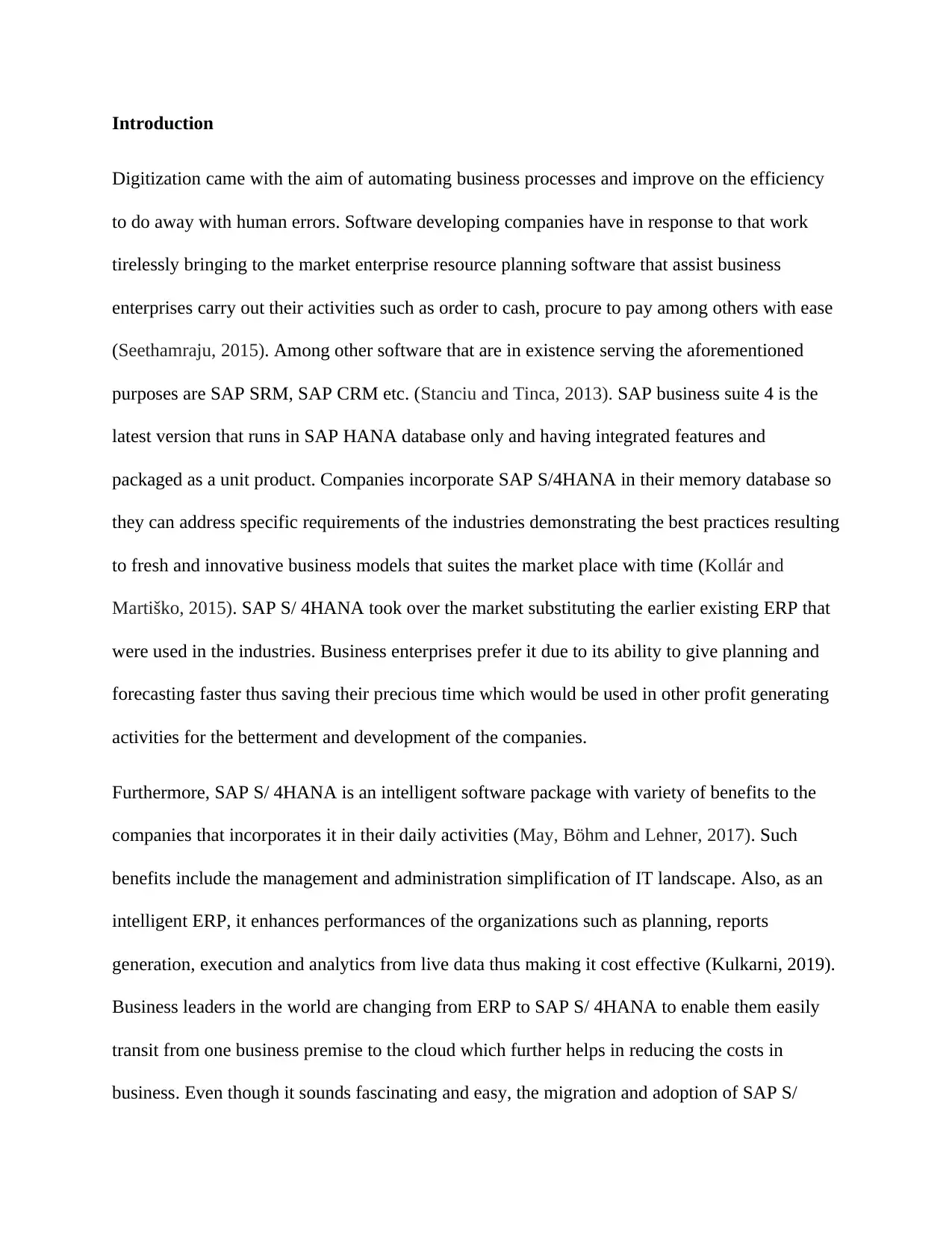
Introduction
Digitization came with the aim of automating business processes and improve on the efficiency
to do away with human errors. Software developing companies have in response to that work
tirelessly bringing to the market enterprise resource planning software that assist business
enterprises carry out their activities such as order to cash, procure to pay among others with ease
(Seethamraju, 2015). Among other software that are in existence serving the aforementioned
purposes are SAP SRM, SAP CRM etc. (Stanciu and Tinca, 2013). SAP business suite 4 is the
latest version that runs in SAP HANA database only and having integrated features and
packaged as a unit product. Companies incorporate SAP S/4HANA in their memory database so
they can address specific requirements of the industries demonstrating the best practices resulting
to fresh and innovative business models that suites the market place with time (Kollár and
Martiško, 2015). SAP S/ 4HANA took over the market substituting the earlier existing ERP that
were used in the industries. Business enterprises prefer it due to its ability to give planning and
forecasting faster thus saving their precious time which would be used in other profit generating
activities for the betterment and development of the companies.
Furthermore, SAP S/ 4HANA is an intelligent software package with variety of benefits to the
companies that incorporates it in their daily activities (May, Böhm and Lehner, 2017) . Such
benefits include the management and administration simplification of IT landscape. Also, as an
intelligent ERP, it enhances performances of the organizations such as planning, reports
generation, execution and analytics from live data thus making it cost effective (Kulkarni, 2019).
Business leaders in the world are changing from ERP to SAP S/ 4HANA to enable them easily
transit from one business premise to the cloud which further helps in reducing the costs in
business. Even though it sounds fascinating and easy, the migration and adoption of SAP S/
Digitization came with the aim of automating business processes and improve on the efficiency
to do away with human errors. Software developing companies have in response to that work
tirelessly bringing to the market enterprise resource planning software that assist business
enterprises carry out their activities such as order to cash, procure to pay among others with ease
(Seethamraju, 2015). Among other software that are in existence serving the aforementioned
purposes are SAP SRM, SAP CRM etc. (Stanciu and Tinca, 2013). SAP business suite 4 is the
latest version that runs in SAP HANA database only and having integrated features and
packaged as a unit product. Companies incorporate SAP S/4HANA in their memory database so
they can address specific requirements of the industries demonstrating the best practices resulting
to fresh and innovative business models that suites the market place with time (Kollár and
Martiško, 2015). SAP S/ 4HANA took over the market substituting the earlier existing ERP that
were used in the industries. Business enterprises prefer it due to its ability to give planning and
forecasting faster thus saving their precious time which would be used in other profit generating
activities for the betterment and development of the companies.
Furthermore, SAP S/ 4HANA is an intelligent software package with variety of benefits to the
companies that incorporates it in their daily activities (May, Böhm and Lehner, 2017) . Such
benefits include the management and administration simplification of IT landscape. Also, as an
intelligent ERP, it enhances performances of the organizations such as planning, reports
generation, execution and analytics from live data thus making it cost effective (Kulkarni, 2019).
Business leaders in the world are changing from ERP to SAP S/ 4HANA to enable them easily
transit from one business premise to the cloud which further helps in reducing the costs in
business. Even though it sounds fascinating and easy, the migration and adoption of SAP S/
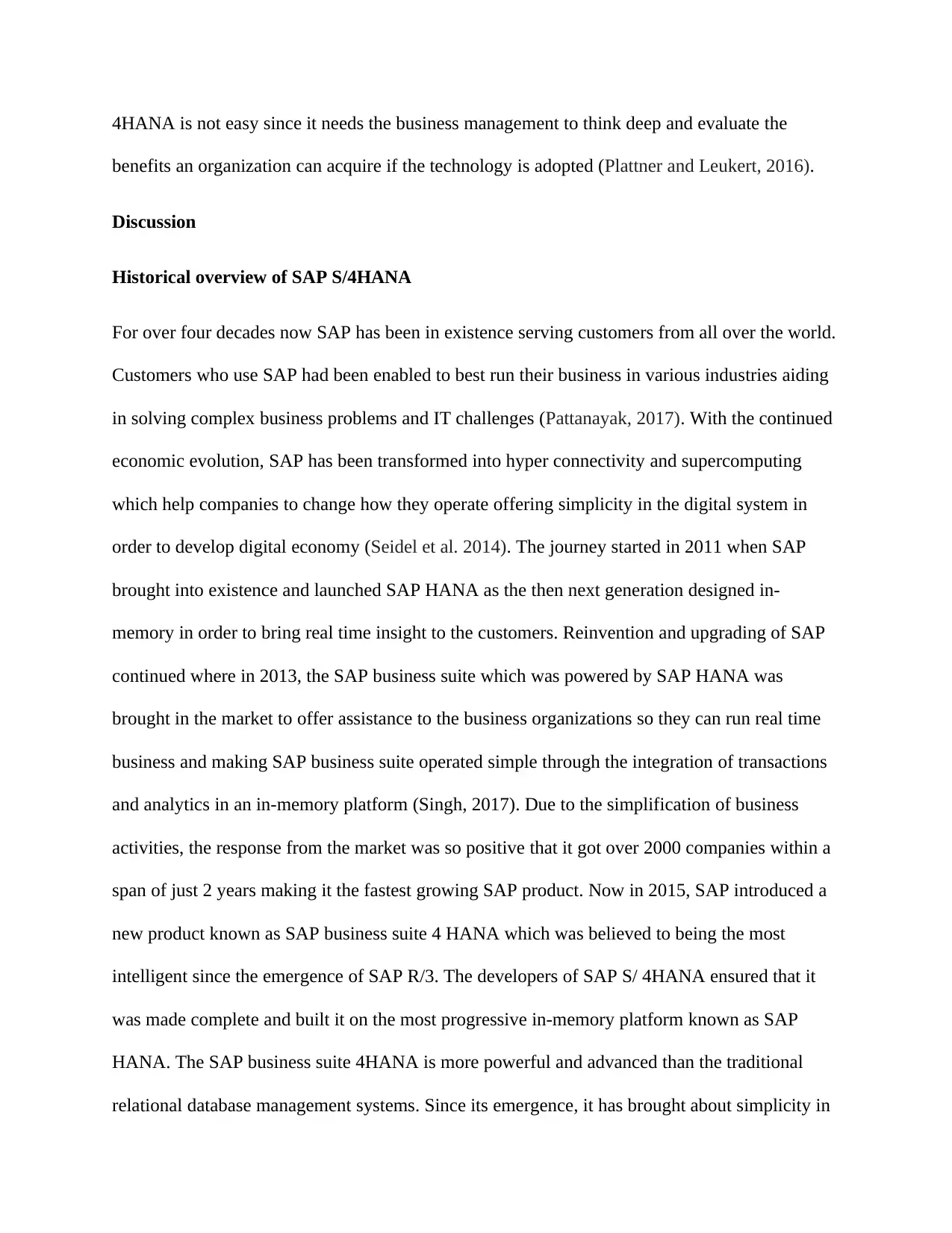
4HANA is not easy since it needs the business management to think deep and evaluate the
benefits an organization can acquire if the technology is adopted (Plattner and Leukert, 2016).
Discussion
Historical overview of SAP S/4HANA
For over four decades now SAP has been in existence serving customers from all over the world.
Customers who use SAP had been enabled to best run their business in various industries aiding
in solving complex business problems and IT challenges (Pattanayak, 2017). With the continued
economic evolution, SAP has been transformed into hyper connectivity and supercomputing
which help companies to change how they operate offering simplicity in the digital system in
order to develop digital economy (Seidel et al. 2014). The journey started in 2011 when SAP
brought into existence and launched SAP HANA as the then next generation designed in-
memory in order to bring real time insight to the customers. Reinvention and upgrading of SAP
continued where in 2013, the SAP business suite which was powered by SAP HANA was
brought in the market to offer assistance to the business organizations so they can run real time
business and making SAP business suite operated simple through the integration of transactions
and analytics in an in-memory platform (Singh, 2017). Due to the simplification of business
activities, the response from the market was so positive that it got over 2000 companies within a
span of just 2 years making it the fastest growing SAP product. Now in 2015, SAP introduced a
new product known as SAP business suite 4 HANA which was believed to being the most
intelligent since the emergence of SAP R/3. The developers of SAP S/ 4HANA ensured that it
was made complete and built it on the most progressive in-memory platform known as SAP
HANA. The SAP business suite 4HANA is more powerful and advanced than the traditional
relational database management systems. Since its emergence, it has brought about simplicity in
benefits an organization can acquire if the technology is adopted (Plattner and Leukert, 2016).
Discussion
Historical overview of SAP S/4HANA
For over four decades now SAP has been in existence serving customers from all over the world.
Customers who use SAP had been enabled to best run their business in various industries aiding
in solving complex business problems and IT challenges (Pattanayak, 2017). With the continued
economic evolution, SAP has been transformed into hyper connectivity and supercomputing
which help companies to change how they operate offering simplicity in the digital system in
order to develop digital economy (Seidel et al. 2014). The journey started in 2011 when SAP
brought into existence and launched SAP HANA as the then next generation designed in-
memory in order to bring real time insight to the customers. Reinvention and upgrading of SAP
continued where in 2013, the SAP business suite which was powered by SAP HANA was
brought in the market to offer assistance to the business organizations so they can run real time
business and making SAP business suite operated simple through the integration of transactions
and analytics in an in-memory platform (Singh, 2017). Due to the simplification of business
activities, the response from the market was so positive that it got over 2000 companies within a
span of just 2 years making it the fastest growing SAP product. Now in 2015, SAP introduced a
new product known as SAP business suite 4 HANA which was believed to being the most
intelligent since the emergence of SAP R/3. The developers of SAP S/ 4HANA ensured that it
was made complete and built it on the most progressive in-memory platform known as SAP
HANA. The SAP business suite 4HANA is more powerful and advanced than the traditional
relational database management systems. Since its emergence, it has brought about simplicity in
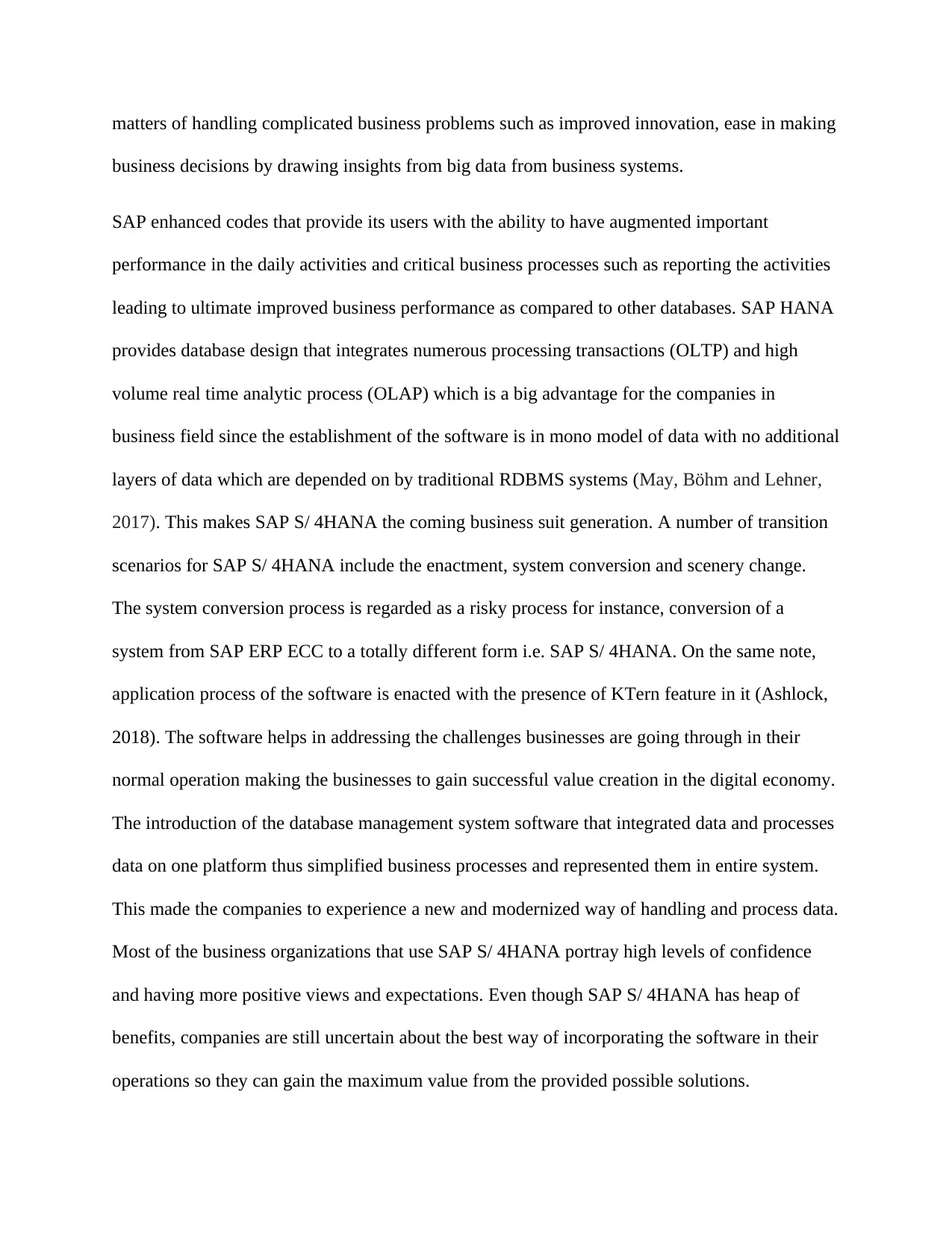
matters of handling complicated business problems such as improved innovation, ease in making
business decisions by drawing insights from big data from business systems.
SAP enhanced codes that provide its users with the ability to have augmented important
performance in the daily activities and critical business processes such as reporting the activities
leading to ultimate improved business performance as compared to other databases. SAP HANA
provides database design that integrates numerous processing transactions (OLTP) and high
volume real time analytic process (OLAP) which is a big advantage for the companies in
business field since the establishment of the software is in mono model of data with no additional
layers of data which are depended on by traditional RDBMS systems (May, Böhm and Lehner,
2017). This makes SAP S/ 4HANA the coming business suit generation. A number of transition
scenarios for SAP S/ 4HANA include the enactment, system conversion and scenery change.
The system conversion process is regarded as a risky process for instance, conversion of a
system from SAP ERP ECC to a totally different form i.e. SAP S/ 4HANA. On the same note,
application process of the software is enacted with the presence of KTern feature in it (Ashlock,
2018). The software helps in addressing the challenges businesses are going through in their
normal operation making the businesses to gain successful value creation in the digital economy.
The introduction of the database management system software that integrated data and processes
data on one platform thus simplified business processes and represented them in entire system.
This made the companies to experience a new and modernized way of handling and process data.
Most of the business organizations that use SAP S/ 4HANA portray high levels of confidence
and having more positive views and expectations. Even though SAP S/ 4HANA has heap of
benefits, companies are still uncertain about the best way of incorporating the software in their
operations so they can gain the maximum value from the provided possible solutions.
business decisions by drawing insights from big data from business systems.
SAP enhanced codes that provide its users with the ability to have augmented important
performance in the daily activities and critical business processes such as reporting the activities
leading to ultimate improved business performance as compared to other databases. SAP HANA
provides database design that integrates numerous processing transactions (OLTP) and high
volume real time analytic process (OLAP) which is a big advantage for the companies in
business field since the establishment of the software is in mono model of data with no additional
layers of data which are depended on by traditional RDBMS systems (May, Böhm and Lehner,
2017). This makes SAP S/ 4HANA the coming business suit generation. A number of transition
scenarios for SAP S/ 4HANA include the enactment, system conversion and scenery change.
The system conversion process is regarded as a risky process for instance, conversion of a
system from SAP ERP ECC to a totally different form i.e. SAP S/ 4HANA. On the same note,
application process of the software is enacted with the presence of KTern feature in it (Ashlock,
2018). The software helps in addressing the challenges businesses are going through in their
normal operation making the businesses to gain successful value creation in the digital economy.
The introduction of the database management system software that integrated data and processes
data on one platform thus simplified business processes and represented them in entire system.
This made the companies to experience a new and modernized way of handling and process data.
Most of the business organizations that use SAP S/ 4HANA portray high levels of confidence
and having more positive views and expectations. Even though SAP S/ 4HANA has heap of
benefits, companies are still uncertain about the best way of incorporating the software in their
operations so they can gain the maximum value from the provided possible solutions.
Secure Best Marks with AI Grader
Need help grading? Try our AI Grader for instant feedback on your assignments.
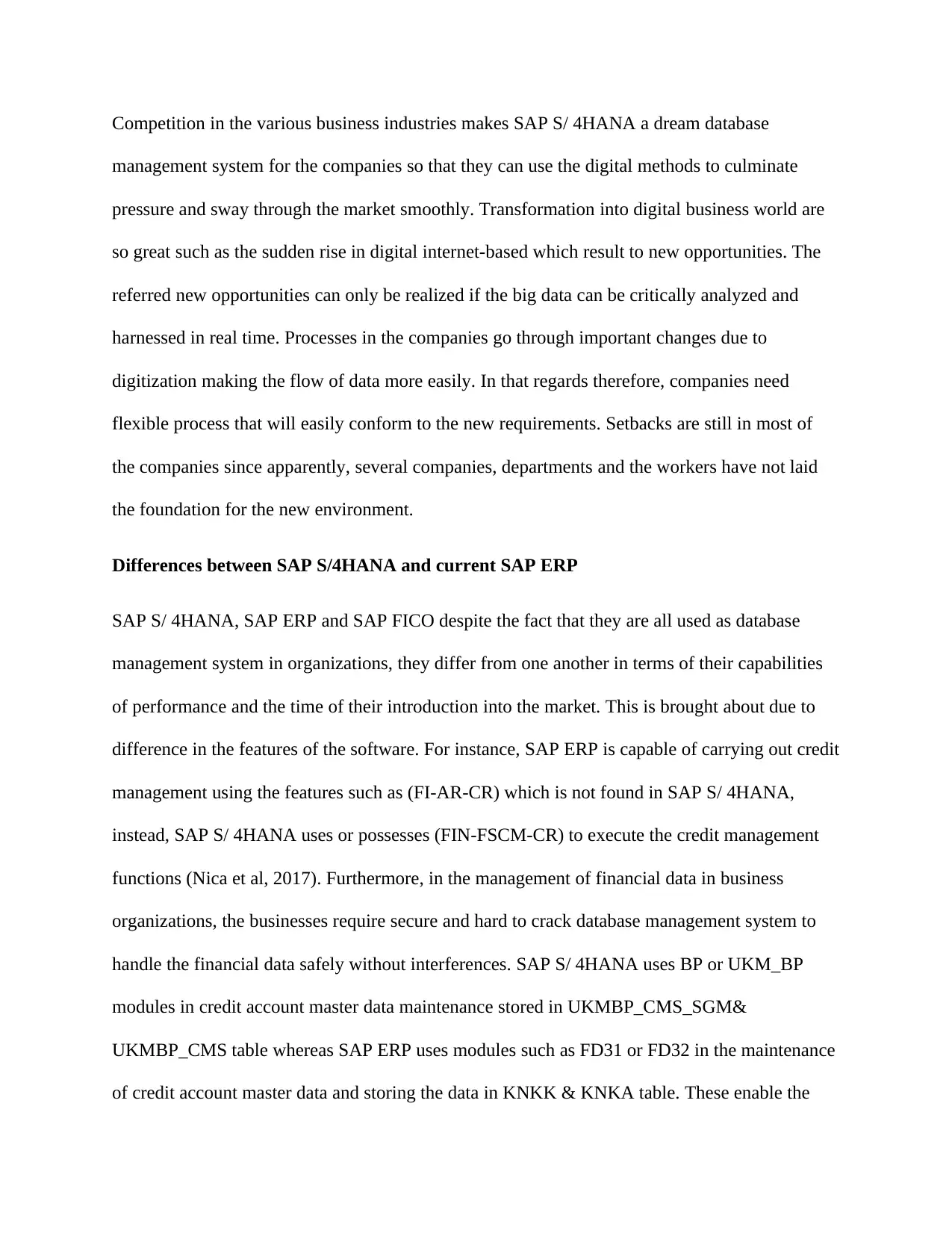
Competition in the various business industries makes SAP S/ 4HANA a dream database
management system for the companies so that they can use the digital methods to culminate
pressure and sway through the market smoothly. Transformation into digital business world are
so great such as the sudden rise in digital internet-based which result to new opportunities. The
referred new opportunities can only be realized if the big data can be critically analyzed and
harnessed in real time. Processes in the companies go through important changes due to
digitization making the flow of data more easily. In that regards therefore, companies need
flexible process that will easily conform to the new requirements. Setbacks are still in most of
the companies since apparently, several companies, departments and the workers have not laid
the foundation for the new environment.
Differences between SAP S/4HANA and current SAP ERP
SAP S/ 4HANA, SAP ERP and SAP FICO despite the fact that they are all used as database
management system in organizations, they differ from one another in terms of their capabilities
of performance and the time of their introduction into the market. This is brought about due to
difference in the features of the software. For instance, SAP ERP is capable of carrying out credit
management using the features such as (FI-AR-CR) which is not found in SAP S/ 4HANA,
instead, SAP S/ 4HANA uses or possesses (FIN-FSCM-CR) to execute the credit management
functions (Nica et al, 2017). Furthermore, in the management of financial data in business
organizations, the businesses require secure and hard to crack database management system to
handle the financial data safely without interferences. SAP S/ 4HANA uses BP or UKM_BP
modules in credit account master data maintenance stored in UKMBP_CMS_SGM&
UKMBP_CMS table whereas SAP ERP uses modules such as FD31 or FD32 in the maintenance
of credit account master data and storing the data in KNKK & KNKA table. These enable the
management system for the companies so that they can use the digital methods to culminate
pressure and sway through the market smoothly. Transformation into digital business world are
so great such as the sudden rise in digital internet-based which result to new opportunities. The
referred new opportunities can only be realized if the big data can be critically analyzed and
harnessed in real time. Processes in the companies go through important changes due to
digitization making the flow of data more easily. In that regards therefore, companies need
flexible process that will easily conform to the new requirements. Setbacks are still in most of
the companies since apparently, several companies, departments and the workers have not laid
the foundation for the new environment.
Differences between SAP S/4HANA and current SAP ERP
SAP S/ 4HANA, SAP ERP and SAP FICO despite the fact that they are all used as database
management system in organizations, they differ from one another in terms of their capabilities
of performance and the time of their introduction into the market. This is brought about due to
difference in the features of the software. For instance, SAP ERP is capable of carrying out credit
management using the features such as (FI-AR-CR) which is not found in SAP S/ 4HANA,
instead, SAP S/ 4HANA uses or possesses (FIN-FSCM-CR) to execute the credit management
functions (Nica et al, 2017). Furthermore, in the management of financial data in business
organizations, the businesses require secure and hard to crack database management system to
handle the financial data safely without interferences. SAP S/ 4HANA uses BP or UKM_BP
modules in credit account master data maintenance stored in UKMBP_CMS_SGM&
UKMBP_CMS table whereas SAP ERP uses modules such as FD31 or FD32 in the maintenance
of credit account master data and storing the data in KNKK & KNKA table. These enable the
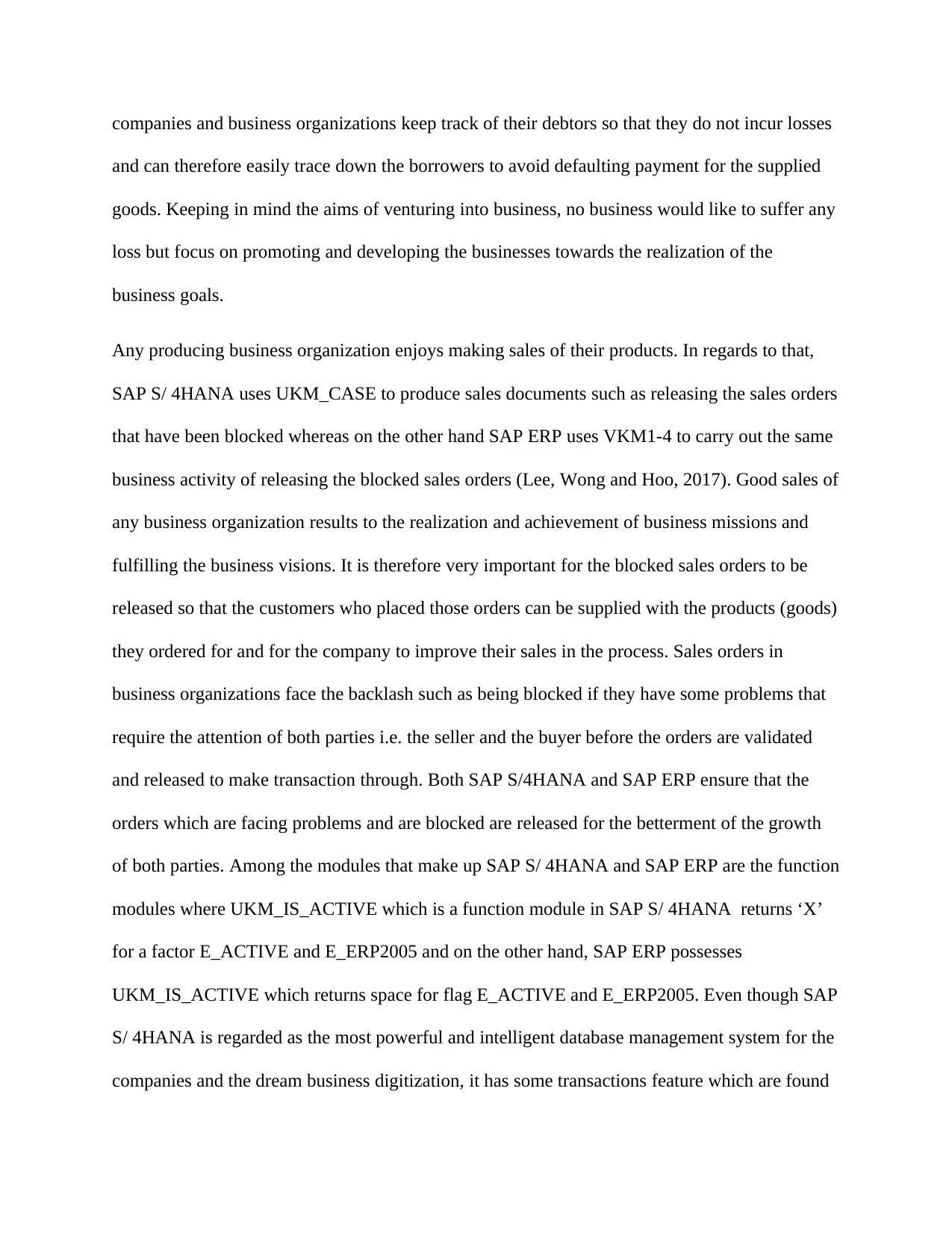
companies and business organizations keep track of their debtors so that they do not incur losses
and can therefore easily trace down the borrowers to avoid defaulting payment for the supplied
goods. Keeping in mind the aims of venturing into business, no business would like to suffer any
loss but focus on promoting and developing the businesses towards the realization of the
business goals.
Any producing business organization enjoys making sales of their products. In regards to that,
SAP S/ 4HANA uses UKM_CASE to produce sales documents such as releasing the sales orders
that have been blocked whereas on the other hand SAP ERP uses VKM1-4 to carry out the same
business activity of releasing the blocked sales orders (Lee, Wong and Hoo, 2017). Good sales of
any business organization results to the realization and achievement of business missions and
fulfilling the business visions. It is therefore very important for the blocked sales orders to be
released so that the customers who placed those orders can be supplied with the products (goods)
they ordered for and for the company to improve their sales in the process. Sales orders in
business organizations face the backlash such as being blocked if they have some problems that
require the attention of both parties i.e. the seller and the buyer before the orders are validated
and released to make transaction through. Both SAP S/4HANA and SAP ERP ensure that the
orders which are facing problems and are blocked are released for the betterment of the growth
of both parties. Among the modules that make up SAP S/ 4HANA and SAP ERP are the function
modules where UKM_IS_ACTIVE which is a function module in SAP S/ 4HANA returns ‘X’
for a factor E_ACTIVE and E_ERP2005 and on the other hand, SAP ERP possesses
UKM_IS_ACTIVE which returns space for flag E_ACTIVE and E_ERP2005. Even though SAP
S/ 4HANA is regarded as the most powerful and intelligent database management system for the
companies and the dream business digitization, it has some transactions feature which are found
and can therefore easily trace down the borrowers to avoid defaulting payment for the supplied
goods. Keeping in mind the aims of venturing into business, no business would like to suffer any
loss but focus on promoting and developing the businesses towards the realization of the
business goals.
Any producing business organization enjoys making sales of their products. In regards to that,
SAP S/ 4HANA uses UKM_CASE to produce sales documents such as releasing the sales orders
that have been blocked whereas on the other hand SAP ERP uses VKM1-4 to carry out the same
business activity of releasing the blocked sales orders (Lee, Wong and Hoo, 2017). Good sales of
any business organization results to the realization and achievement of business missions and
fulfilling the business visions. It is therefore very important for the blocked sales orders to be
released so that the customers who placed those orders can be supplied with the products (goods)
they ordered for and for the company to improve their sales in the process. Sales orders in
business organizations face the backlash such as being blocked if they have some problems that
require the attention of both parties i.e. the seller and the buyer before the orders are validated
and released to make transaction through. Both SAP S/4HANA and SAP ERP ensure that the
orders which are facing problems and are blocked are released for the betterment of the growth
of both parties. Among the modules that make up SAP S/ 4HANA and SAP ERP are the function
modules where UKM_IS_ACTIVE which is a function module in SAP S/ 4HANA returns ‘X’
for a factor E_ACTIVE and E_ERP2005 and on the other hand, SAP ERP possesses
UKM_IS_ACTIVE which returns space for flag E_ACTIVE and E_ERP2005. Even though SAP
S/ 4HANA is regarded as the most powerful and intelligent database management system for the
companies and the dream business digitization, it has some transactions feature which are found
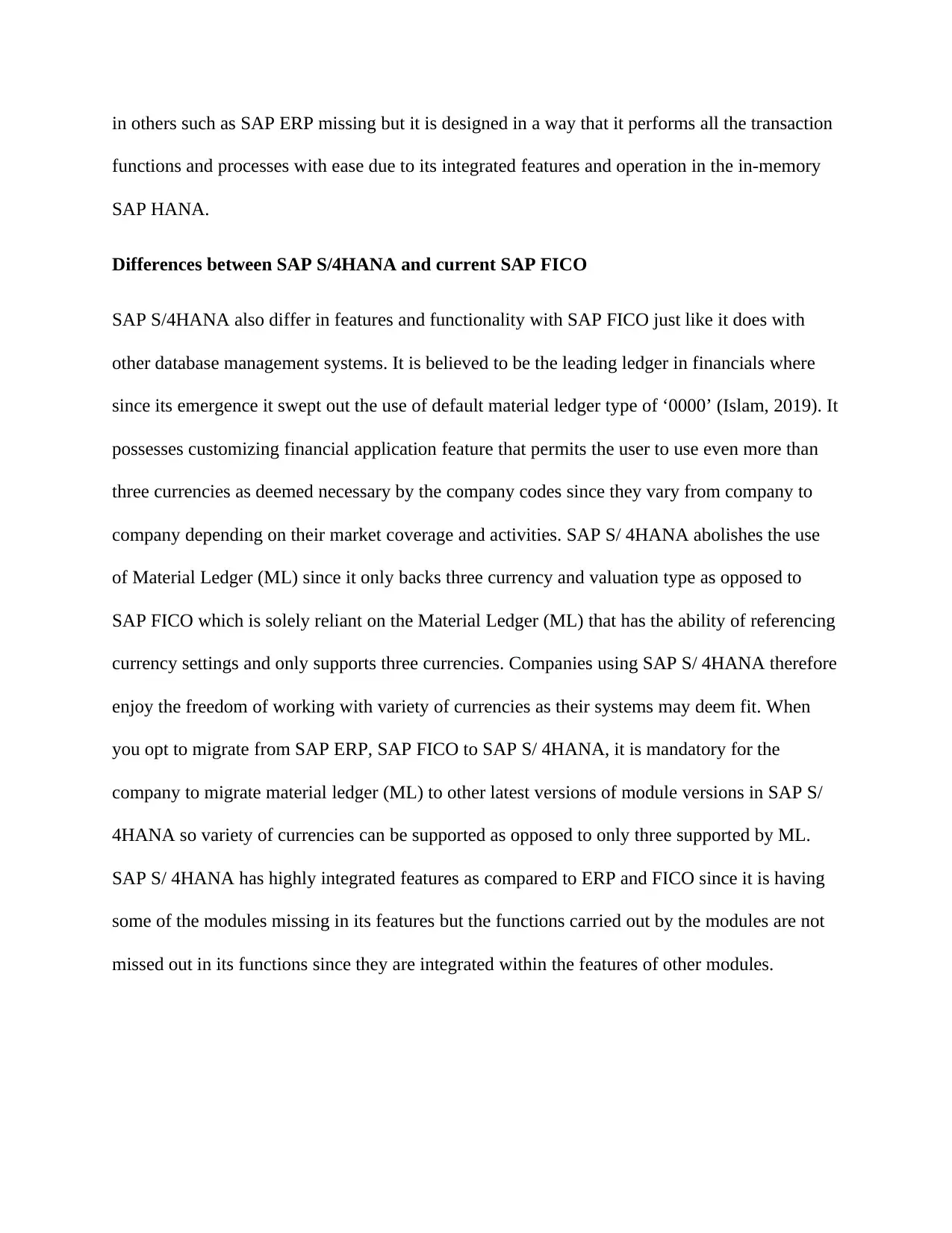
in others such as SAP ERP missing but it is designed in a way that it performs all the transaction
functions and processes with ease due to its integrated features and operation in the in-memory
SAP HANA.
Differences between SAP S/4HANA and current SAP FICO
SAP S/4HANA also differ in features and functionality with SAP FICO just like it does with
other database management systems. It is believed to be the leading ledger in financials where
since its emergence it swept out the use of default material ledger type of ‘0000’ (Islam, 2019). It
possesses customizing financial application feature that permits the user to use even more than
three currencies as deemed necessary by the company codes since they vary from company to
company depending on their market coverage and activities. SAP S/ 4HANA abolishes the use
of Material Ledger (ML) since it only backs three currency and valuation type as opposed to
SAP FICO which is solely reliant on the Material Ledger (ML) that has the ability of referencing
currency settings and only supports three currencies. Companies using SAP S/ 4HANA therefore
enjoy the freedom of working with variety of currencies as their systems may deem fit. When
you opt to migrate from SAP ERP, SAP FICO to SAP S/ 4HANA, it is mandatory for the
company to migrate material ledger (ML) to other latest versions of module versions in SAP S/
4HANA so variety of currencies can be supported as opposed to only three supported by ML.
SAP S/ 4HANA has highly integrated features as compared to ERP and FICO since it is having
some of the modules missing in its features but the functions carried out by the modules are not
missed out in its functions since they are integrated within the features of other modules.
functions and processes with ease due to its integrated features and operation in the in-memory
SAP HANA.
Differences between SAP S/4HANA and current SAP FICO
SAP S/4HANA also differ in features and functionality with SAP FICO just like it does with
other database management systems. It is believed to be the leading ledger in financials where
since its emergence it swept out the use of default material ledger type of ‘0000’ (Islam, 2019). It
possesses customizing financial application feature that permits the user to use even more than
three currencies as deemed necessary by the company codes since they vary from company to
company depending on their market coverage and activities. SAP S/ 4HANA abolishes the use
of Material Ledger (ML) since it only backs three currency and valuation type as opposed to
SAP FICO which is solely reliant on the Material Ledger (ML) that has the ability of referencing
currency settings and only supports three currencies. Companies using SAP S/ 4HANA therefore
enjoy the freedom of working with variety of currencies as their systems may deem fit. When
you opt to migrate from SAP ERP, SAP FICO to SAP S/ 4HANA, it is mandatory for the
company to migrate material ledger (ML) to other latest versions of module versions in SAP S/
4HANA so variety of currencies can be supported as opposed to only three supported by ML.
SAP S/ 4HANA has highly integrated features as compared to ERP and FICO since it is having
some of the modules missing in its features but the functions carried out by the modules are not
missed out in its functions since they are integrated within the features of other modules.
Paraphrase This Document
Need a fresh take? Get an instant paraphrase of this document with our AI Paraphraser
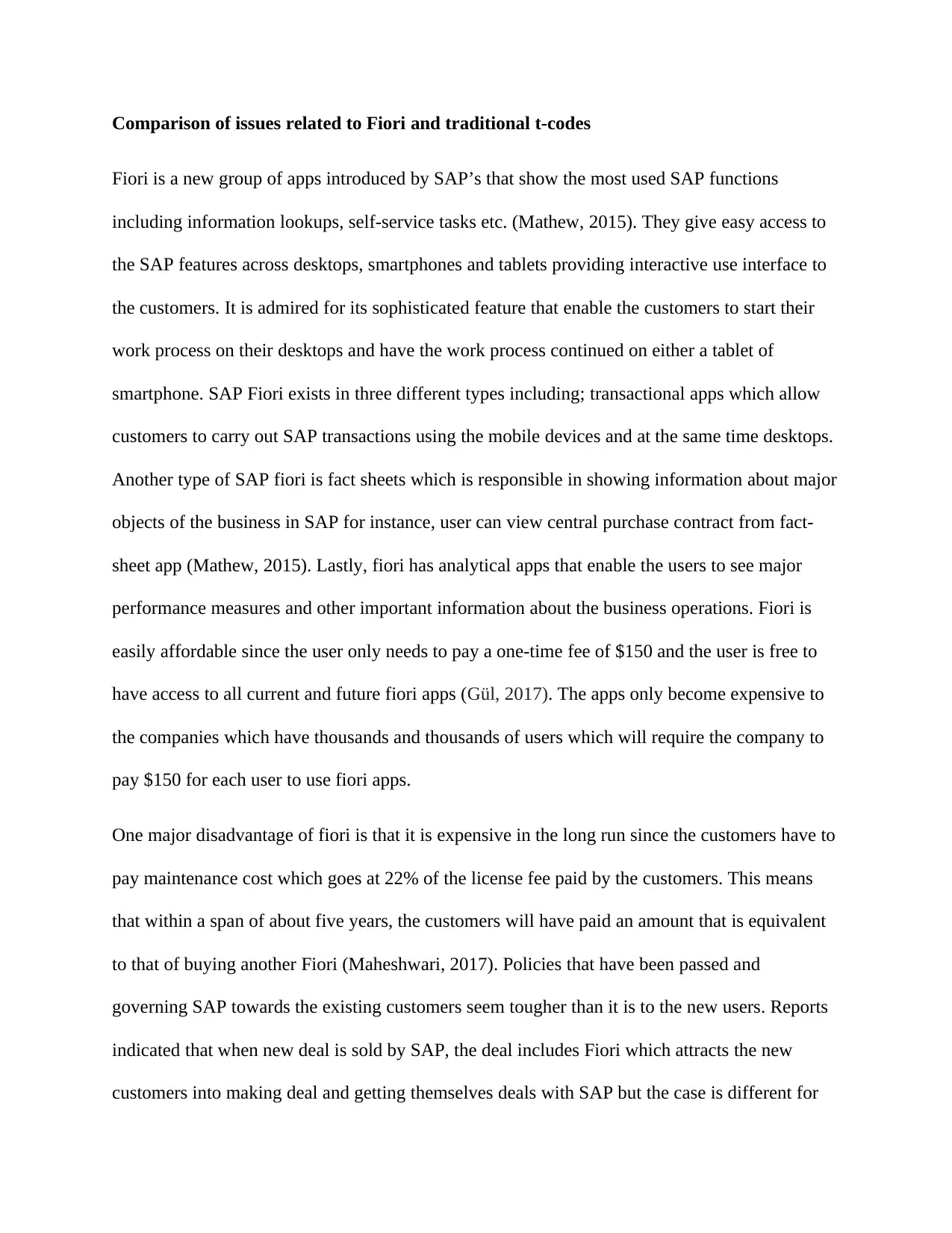
Comparison of issues related to Fiori and traditional t-codes
Fiori is a new group of apps introduced by SAP’s that show the most used SAP functions
including information lookups, self-service tasks etc. (Mathew, 2015). They give easy access to
the SAP features across desktops, smartphones and tablets providing interactive use interface to
the customers. It is admired for its sophisticated feature that enable the customers to start their
work process on their desktops and have the work process continued on either a tablet of
smartphone. SAP Fiori exists in three different types including; transactional apps which allow
customers to carry out SAP transactions using the mobile devices and at the same time desktops.
Another type of SAP fiori is fact sheets which is responsible in showing information about major
objects of the business in SAP for instance, user can view central purchase contract from fact-
sheet app (Mathew, 2015). Lastly, fiori has analytical apps that enable the users to see major
performance measures and other important information about the business operations. Fiori is
easily affordable since the user only needs to pay a one-time fee of $150 and the user is free to
have access to all current and future fiori apps (Gül, 2017). The apps only become expensive to
the companies which have thousands and thousands of users which will require the company to
pay $150 for each user to use fiori apps.
One major disadvantage of fiori is that it is expensive in the long run since the customers have to
pay maintenance cost which goes at 22% of the license fee paid by the customers. This means
that within a span of about five years, the customers will have paid an amount that is equivalent
to that of buying another Fiori (Maheshwari, 2017). Policies that have been passed and
governing SAP towards the existing customers seem tougher than it is to the new users. Reports
indicated that when new deal is sold by SAP, the deal includes Fiori which attracts the new
customers into making deal and getting themselves deals with SAP but the case is different for
Fiori is a new group of apps introduced by SAP’s that show the most used SAP functions
including information lookups, self-service tasks etc. (Mathew, 2015). They give easy access to
the SAP features across desktops, smartphones and tablets providing interactive use interface to
the customers. It is admired for its sophisticated feature that enable the customers to start their
work process on their desktops and have the work process continued on either a tablet of
smartphone. SAP Fiori exists in three different types including; transactional apps which allow
customers to carry out SAP transactions using the mobile devices and at the same time desktops.
Another type of SAP fiori is fact sheets which is responsible in showing information about major
objects of the business in SAP for instance, user can view central purchase contract from fact-
sheet app (Mathew, 2015). Lastly, fiori has analytical apps that enable the users to see major
performance measures and other important information about the business operations. Fiori is
easily affordable since the user only needs to pay a one-time fee of $150 and the user is free to
have access to all current and future fiori apps (Gül, 2017). The apps only become expensive to
the companies which have thousands and thousands of users which will require the company to
pay $150 for each user to use fiori apps.
One major disadvantage of fiori is that it is expensive in the long run since the customers have to
pay maintenance cost which goes at 22% of the license fee paid by the customers. This means
that within a span of about five years, the customers will have paid an amount that is equivalent
to that of buying another Fiori (Maheshwari, 2017). Policies that have been passed and
governing SAP towards the existing customers seem tougher than it is to the new users. Reports
indicated that when new deal is sold by SAP, the deal includes Fiori which attracts the new
customers into making deal and getting themselves deals with SAP but the case is different for
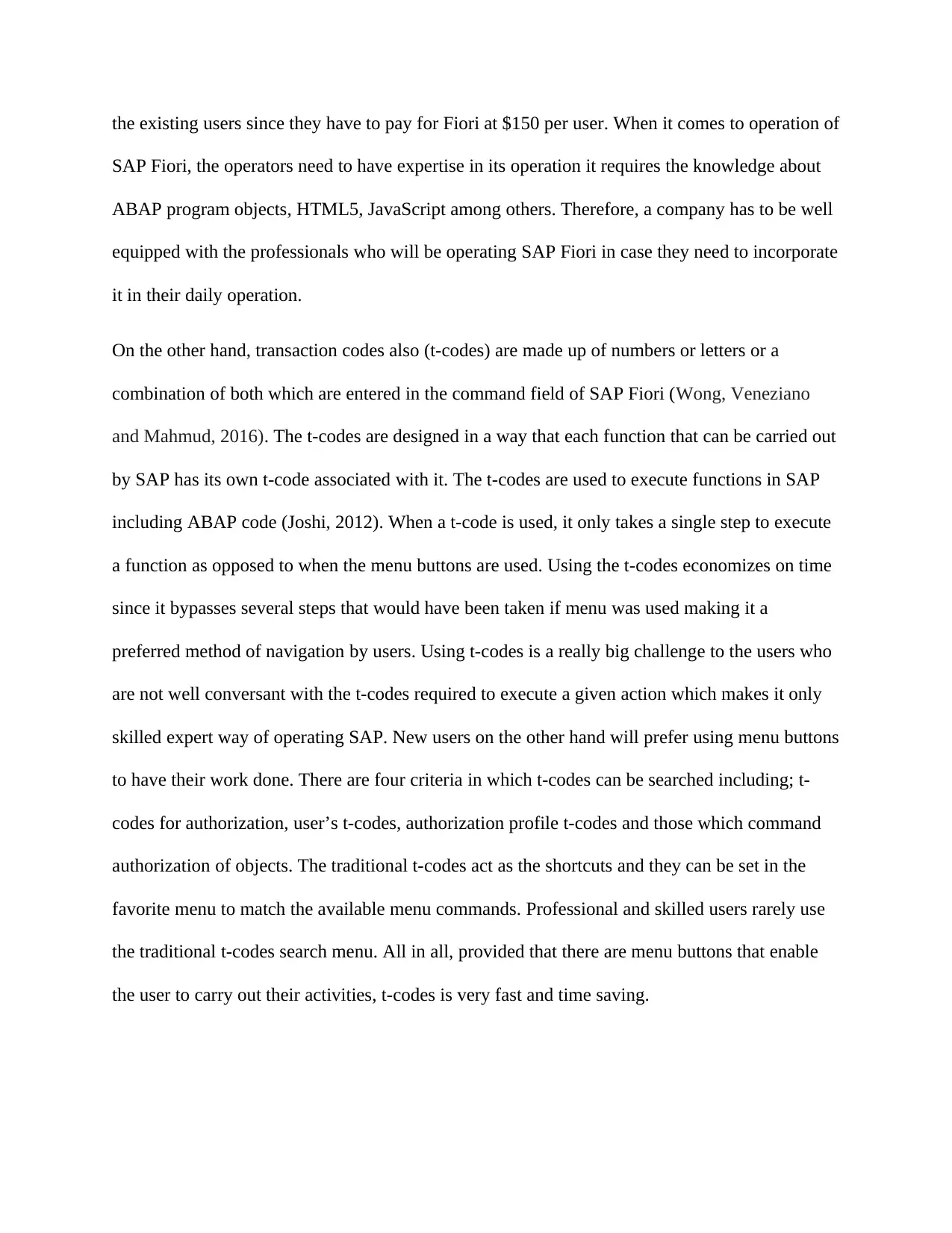
the existing users since they have to pay for Fiori at $150 per user. When it comes to operation of
SAP Fiori, the operators need to have expertise in its operation it requires the knowledge about
ABAP program objects, HTML5, JavaScript among others. Therefore, a company has to be well
equipped with the professionals who will be operating SAP Fiori in case they need to incorporate
it in their daily operation.
On the other hand, transaction codes also (t-codes) are made up of numbers or letters or a
combination of both which are entered in the command field of SAP Fiori (Wong, Veneziano
and Mahmud, 2016). The t-codes are designed in a way that each function that can be carried out
by SAP has its own t-code associated with it. The t-codes are used to execute functions in SAP
including ABAP code (Joshi, 2012). When a t-code is used, it only takes a single step to execute
a function as opposed to when the menu buttons are used. Using the t-codes economizes on time
since it bypasses several steps that would have been taken if menu was used making it a
preferred method of navigation by users. Using t-codes is a really big challenge to the users who
are not well conversant with the t-codes required to execute a given action which makes it only
skilled expert way of operating SAP. New users on the other hand will prefer using menu buttons
to have their work done. There are four criteria in which t-codes can be searched including; t-
codes for authorization, user’s t-codes, authorization profile t-codes and those which command
authorization of objects. The traditional t-codes act as the shortcuts and they can be set in the
favorite menu to match the available menu commands. Professional and skilled users rarely use
the traditional t-codes search menu. All in all, provided that there are menu buttons that enable
the user to carry out their activities, t-codes is very fast and time saving.
SAP Fiori, the operators need to have expertise in its operation it requires the knowledge about
ABAP program objects, HTML5, JavaScript among others. Therefore, a company has to be well
equipped with the professionals who will be operating SAP Fiori in case they need to incorporate
it in their daily operation.
On the other hand, transaction codes also (t-codes) are made up of numbers or letters or a
combination of both which are entered in the command field of SAP Fiori (Wong, Veneziano
and Mahmud, 2016). The t-codes are designed in a way that each function that can be carried out
by SAP has its own t-code associated with it. The t-codes are used to execute functions in SAP
including ABAP code (Joshi, 2012). When a t-code is used, it only takes a single step to execute
a function as opposed to when the menu buttons are used. Using the t-codes economizes on time
since it bypasses several steps that would have been taken if menu was used making it a
preferred method of navigation by users. Using t-codes is a really big challenge to the users who
are not well conversant with the t-codes required to execute a given action which makes it only
skilled expert way of operating SAP. New users on the other hand will prefer using menu buttons
to have their work done. There are four criteria in which t-codes can be searched including; t-
codes for authorization, user’s t-codes, authorization profile t-codes and those which command
authorization of objects. The traditional t-codes act as the shortcuts and they can be set in the
favorite menu to match the available menu commands. Professional and skilled users rarely use
the traditional t-codes search menu. All in all, provided that there are menu buttons that enable
the user to carry out their activities, t-codes is very fast and time saving.
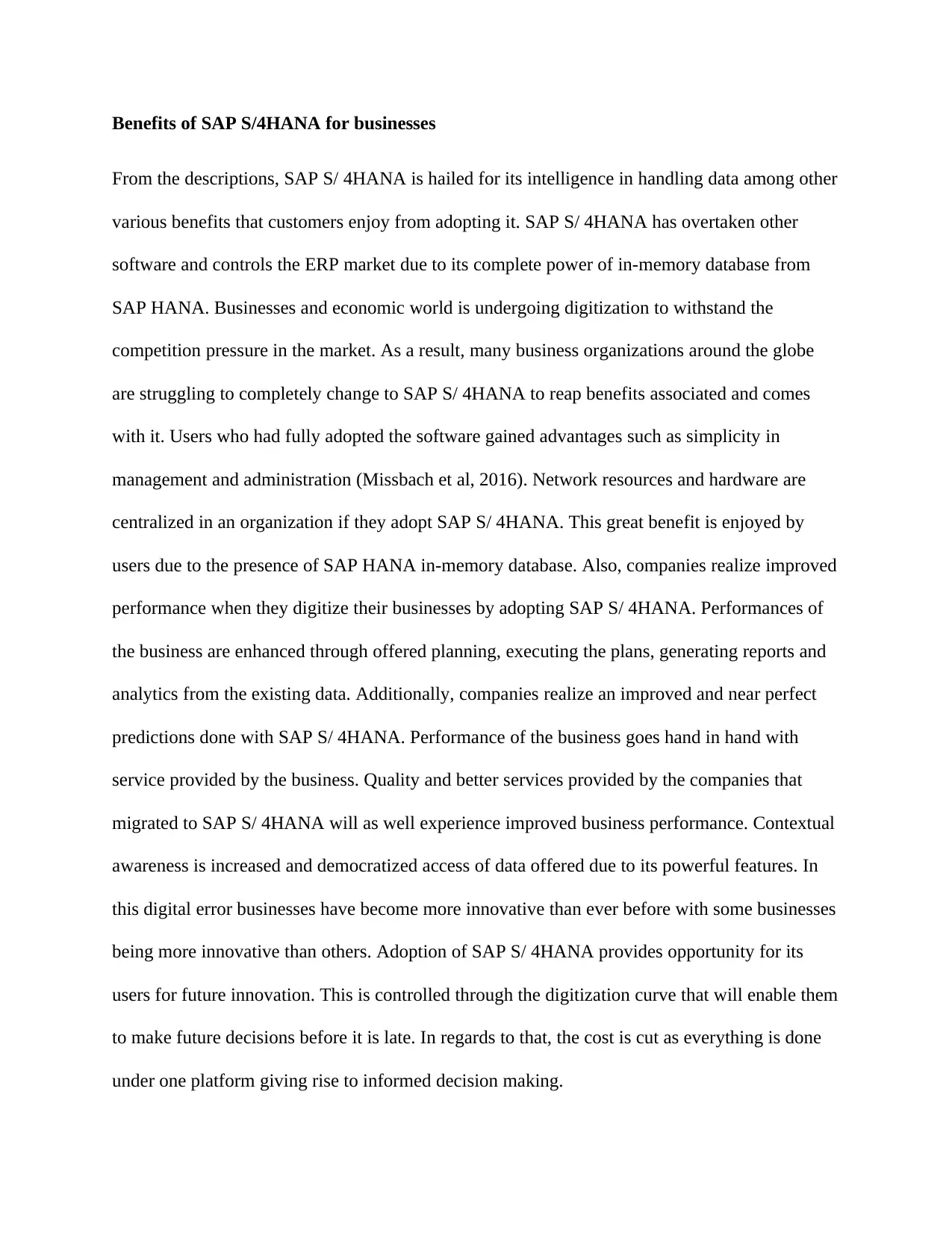
Benefits of SAP S/4HANA for businesses
From the descriptions, SAP S/ 4HANA is hailed for its intelligence in handling data among other
various benefits that customers enjoy from adopting it. SAP S/ 4HANA has overtaken other
software and controls the ERP market due to its complete power of in-memory database from
SAP HANA. Businesses and economic world is undergoing digitization to withstand the
competition pressure in the market. As a result, many business organizations around the globe
are struggling to completely change to SAP S/ 4HANA to reap benefits associated and comes
with it. Users who had fully adopted the software gained advantages such as simplicity in
management and administration (Missbach et al, 2016). Network resources and hardware are
centralized in an organization if they adopt SAP S/ 4HANA. This great benefit is enjoyed by
users due to the presence of SAP HANA in-memory database. Also, companies realize improved
performance when they digitize their businesses by adopting SAP S/ 4HANA. Performances of
the business are enhanced through offered planning, executing the plans, generating reports and
analytics from the existing data. Additionally, companies realize an improved and near perfect
predictions done with SAP S/ 4HANA. Performance of the business goes hand in hand with
service provided by the business. Quality and better services provided by the companies that
migrated to SAP S/ 4HANA will as well experience improved business performance. Contextual
awareness is increased and democratized access of data offered due to its powerful features. In
this digital error businesses have become more innovative than ever before with some businesses
being more innovative than others. Adoption of SAP S/ 4HANA provides opportunity for its
users for future innovation. This is controlled through the digitization curve that will enable them
to make future decisions before it is late. In regards to that, the cost is cut as everything is done
under one platform giving rise to informed decision making.
From the descriptions, SAP S/ 4HANA is hailed for its intelligence in handling data among other
various benefits that customers enjoy from adopting it. SAP S/ 4HANA has overtaken other
software and controls the ERP market due to its complete power of in-memory database from
SAP HANA. Businesses and economic world is undergoing digitization to withstand the
competition pressure in the market. As a result, many business organizations around the globe
are struggling to completely change to SAP S/ 4HANA to reap benefits associated and comes
with it. Users who had fully adopted the software gained advantages such as simplicity in
management and administration (Missbach et al, 2016). Network resources and hardware are
centralized in an organization if they adopt SAP S/ 4HANA. This great benefit is enjoyed by
users due to the presence of SAP HANA in-memory database. Also, companies realize improved
performance when they digitize their businesses by adopting SAP S/ 4HANA. Performances of
the business are enhanced through offered planning, executing the plans, generating reports and
analytics from the existing data. Additionally, companies realize an improved and near perfect
predictions done with SAP S/ 4HANA. Performance of the business goes hand in hand with
service provided by the business. Quality and better services provided by the companies that
migrated to SAP S/ 4HANA will as well experience improved business performance. Contextual
awareness is increased and democratized access of data offered due to its powerful features. In
this digital error businesses have become more innovative than ever before with some businesses
being more innovative than others. Adoption of SAP S/ 4HANA provides opportunity for its
users for future innovation. This is controlled through the digitization curve that will enable them
to make future decisions before it is late. In regards to that, the cost is cut as everything is done
under one platform giving rise to informed decision making.
Secure Best Marks with AI Grader
Need help grading? Try our AI Grader for instant feedback on your assignments.
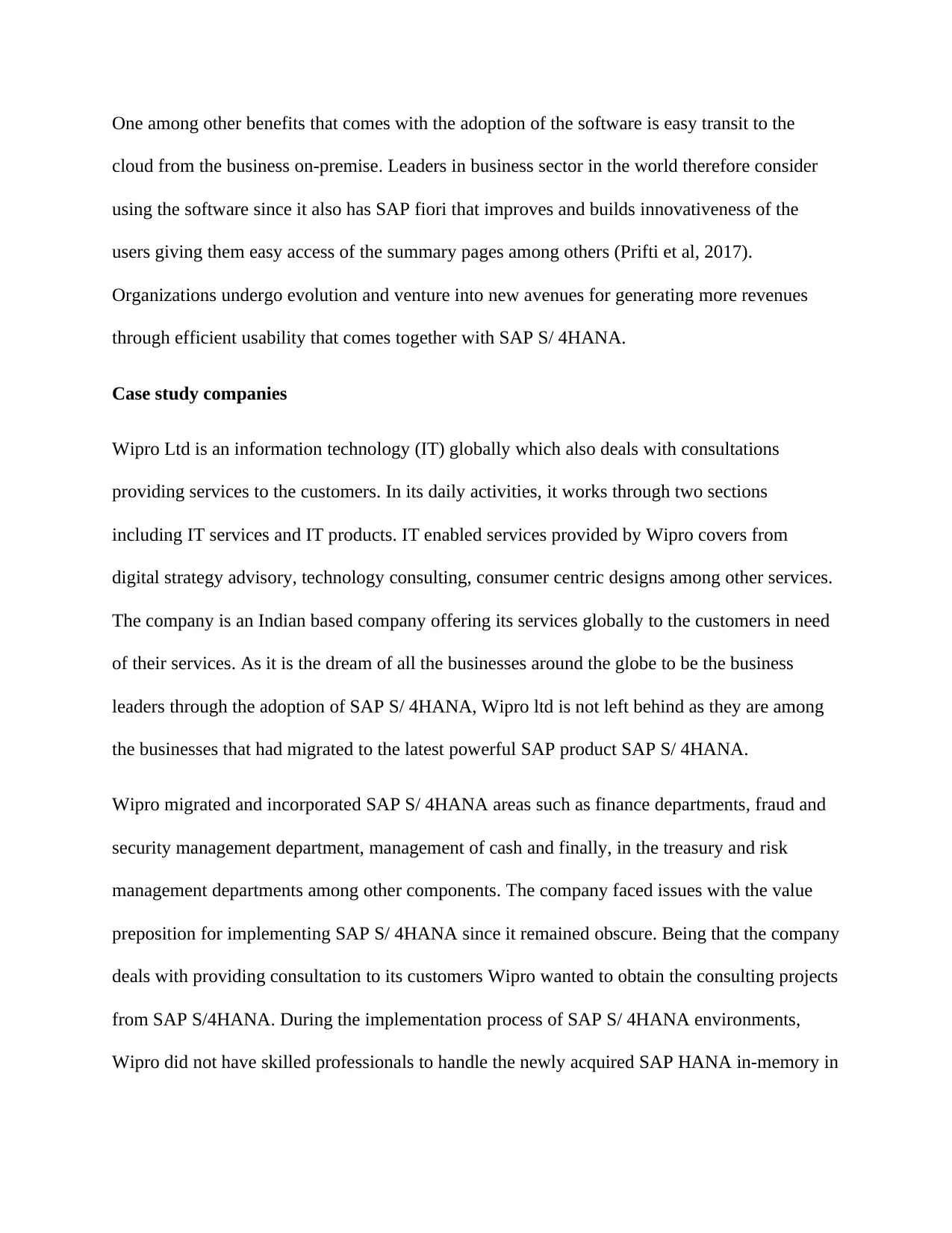
One among other benefits that comes with the adoption of the software is easy transit to the
cloud from the business on-premise. Leaders in business sector in the world therefore consider
using the software since it also has SAP fiori that improves and builds innovativeness of the
users giving them easy access of the summary pages among others (Prifti et al, 2017).
Organizations undergo evolution and venture into new avenues for generating more revenues
through efficient usability that comes together with SAP S/ 4HANA.
Case study companies
Wipro Ltd is an information technology (IT) globally which also deals with consultations
providing services to the customers. In its daily activities, it works through two sections
including IT services and IT products. IT enabled services provided by Wipro covers from
digital strategy advisory, technology consulting, consumer centric designs among other services.
The company is an Indian based company offering its services globally to the customers in need
of their services. As it is the dream of all the businesses around the globe to be the business
leaders through the adoption of SAP S/ 4HANA, Wipro ltd is not left behind as they are among
the businesses that had migrated to the latest powerful SAP product SAP S/ 4HANA.
Wipro migrated and incorporated SAP S/ 4HANA areas such as finance departments, fraud and
security management department, management of cash and finally, in the treasury and risk
management departments among other components. The company faced issues with the value
preposition for implementing SAP S/ 4HANA since it remained obscure. Being that the company
deals with providing consultation to its customers Wipro wanted to obtain the consulting projects
from SAP S/4HANA. During the implementation process of SAP S/ 4HANA environments,
Wipro did not have skilled professionals to handle the newly acquired SAP HANA in-memory in
cloud from the business on-premise. Leaders in business sector in the world therefore consider
using the software since it also has SAP fiori that improves and builds innovativeness of the
users giving them easy access of the summary pages among others (Prifti et al, 2017).
Organizations undergo evolution and venture into new avenues for generating more revenues
through efficient usability that comes together with SAP S/ 4HANA.
Case study companies
Wipro Ltd is an information technology (IT) globally which also deals with consultations
providing services to the customers. In its daily activities, it works through two sections
including IT services and IT products. IT enabled services provided by Wipro covers from
digital strategy advisory, technology consulting, consumer centric designs among other services.
The company is an Indian based company offering its services globally to the customers in need
of their services. As it is the dream of all the businesses around the globe to be the business
leaders through the adoption of SAP S/ 4HANA, Wipro ltd is not left behind as they are among
the businesses that had migrated to the latest powerful SAP product SAP S/ 4HANA.
Wipro migrated and incorporated SAP S/ 4HANA areas such as finance departments, fraud and
security management department, management of cash and finally, in the treasury and risk
management departments among other components. The company faced issues with the value
preposition for implementing SAP S/ 4HANA since it remained obscure. Being that the company
deals with providing consultation to its customers Wipro wanted to obtain the consulting projects
from SAP S/4HANA. During the implementation process of SAP S/ 4HANA environments,
Wipro did not have skilled professionals to handle the newly acquired SAP HANA in-memory in
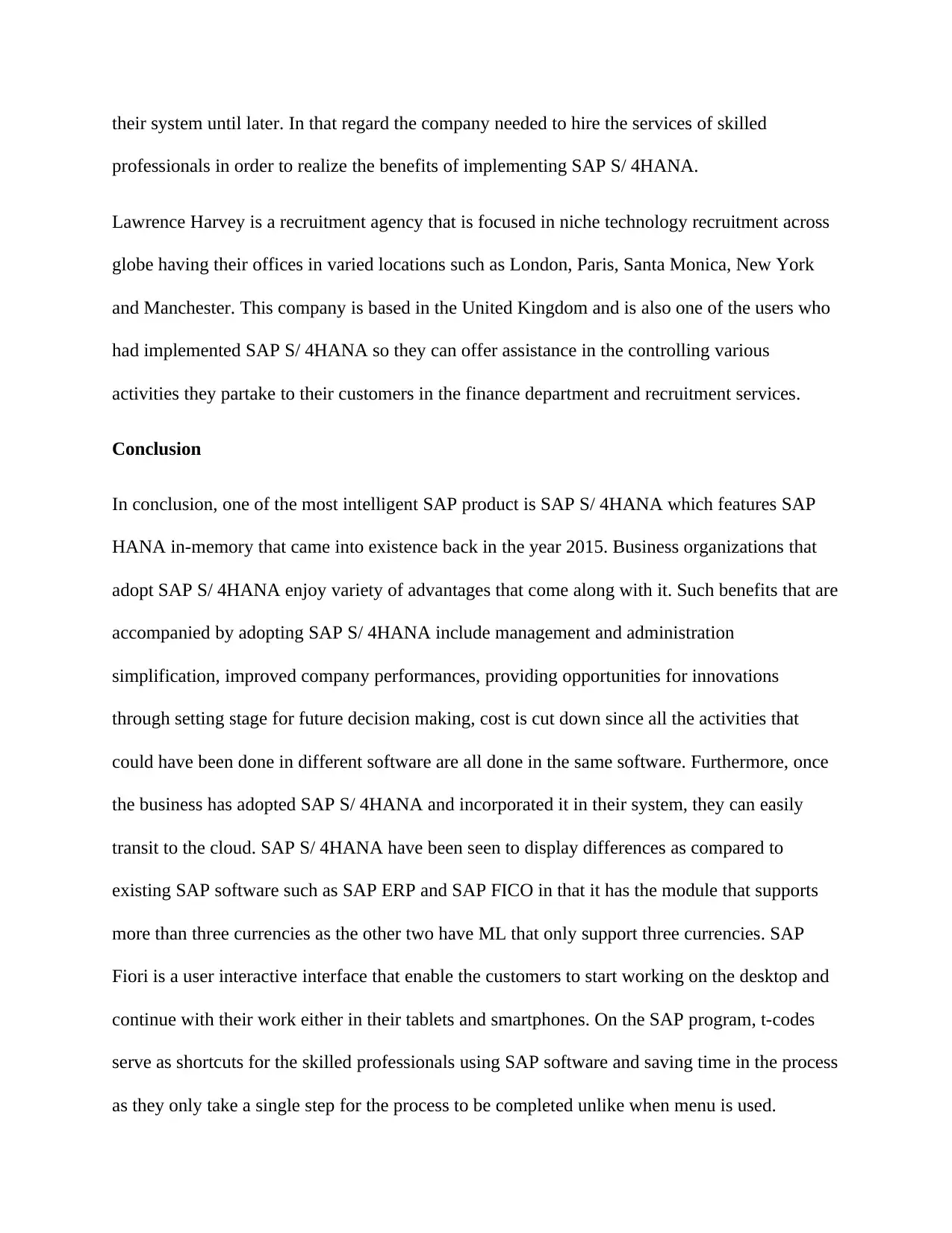
their system until later. In that regard the company needed to hire the services of skilled
professionals in order to realize the benefits of implementing SAP S/ 4HANA.
Lawrence Harvey is a recruitment agency that is focused in niche technology recruitment across
globe having their offices in varied locations such as London, Paris, Santa Monica, New York
and Manchester. This company is based in the United Kingdom and is also one of the users who
had implemented SAP S/ 4HANA so they can offer assistance in the controlling various
activities they partake to their customers in the finance department and recruitment services.
Conclusion
In conclusion, one of the most intelligent SAP product is SAP S/ 4HANA which features SAP
HANA in-memory that came into existence back in the year 2015. Business organizations that
adopt SAP S/ 4HANA enjoy variety of advantages that come along with it. Such benefits that are
accompanied by adopting SAP S/ 4HANA include management and administration
simplification, improved company performances, providing opportunities for innovations
through setting stage for future decision making, cost is cut down since all the activities that
could have been done in different software are all done in the same software. Furthermore, once
the business has adopted SAP S/ 4HANA and incorporated it in their system, they can easily
transit to the cloud. SAP S/ 4HANA have been seen to display differences as compared to
existing SAP software such as SAP ERP and SAP FICO in that it has the module that supports
more than three currencies as the other two have ML that only support three currencies. SAP
Fiori is a user interactive interface that enable the customers to start working on the desktop and
continue with their work either in their tablets and smartphones. On the SAP program, t-codes
serve as shortcuts for the skilled professionals using SAP software and saving time in the process
as they only take a single step for the process to be completed unlike when menu is used.
professionals in order to realize the benefits of implementing SAP S/ 4HANA.
Lawrence Harvey is a recruitment agency that is focused in niche technology recruitment across
globe having their offices in varied locations such as London, Paris, Santa Monica, New York
and Manchester. This company is based in the United Kingdom and is also one of the users who
had implemented SAP S/ 4HANA so they can offer assistance in the controlling various
activities they partake to their customers in the finance department and recruitment services.
Conclusion
In conclusion, one of the most intelligent SAP product is SAP S/ 4HANA which features SAP
HANA in-memory that came into existence back in the year 2015. Business organizations that
adopt SAP S/ 4HANA enjoy variety of advantages that come along with it. Such benefits that are
accompanied by adopting SAP S/ 4HANA include management and administration
simplification, improved company performances, providing opportunities for innovations
through setting stage for future decision making, cost is cut down since all the activities that
could have been done in different software are all done in the same software. Furthermore, once
the business has adopted SAP S/ 4HANA and incorporated it in their system, they can easily
transit to the cloud. SAP S/ 4HANA have been seen to display differences as compared to
existing SAP software such as SAP ERP and SAP FICO in that it has the module that supports
more than three currencies as the other two have ML that only support three currencies. SAP
Fiori is a user interactive interface that enable the customers to start working on the desktop and
continue with their work either in their tablets and smartphones. On the SAP program, t-codes
serve as shortcuts for the skilled professionals using SAP software and saving time in the process
as they only take a single step for the process to be completed unlike when menu is used.
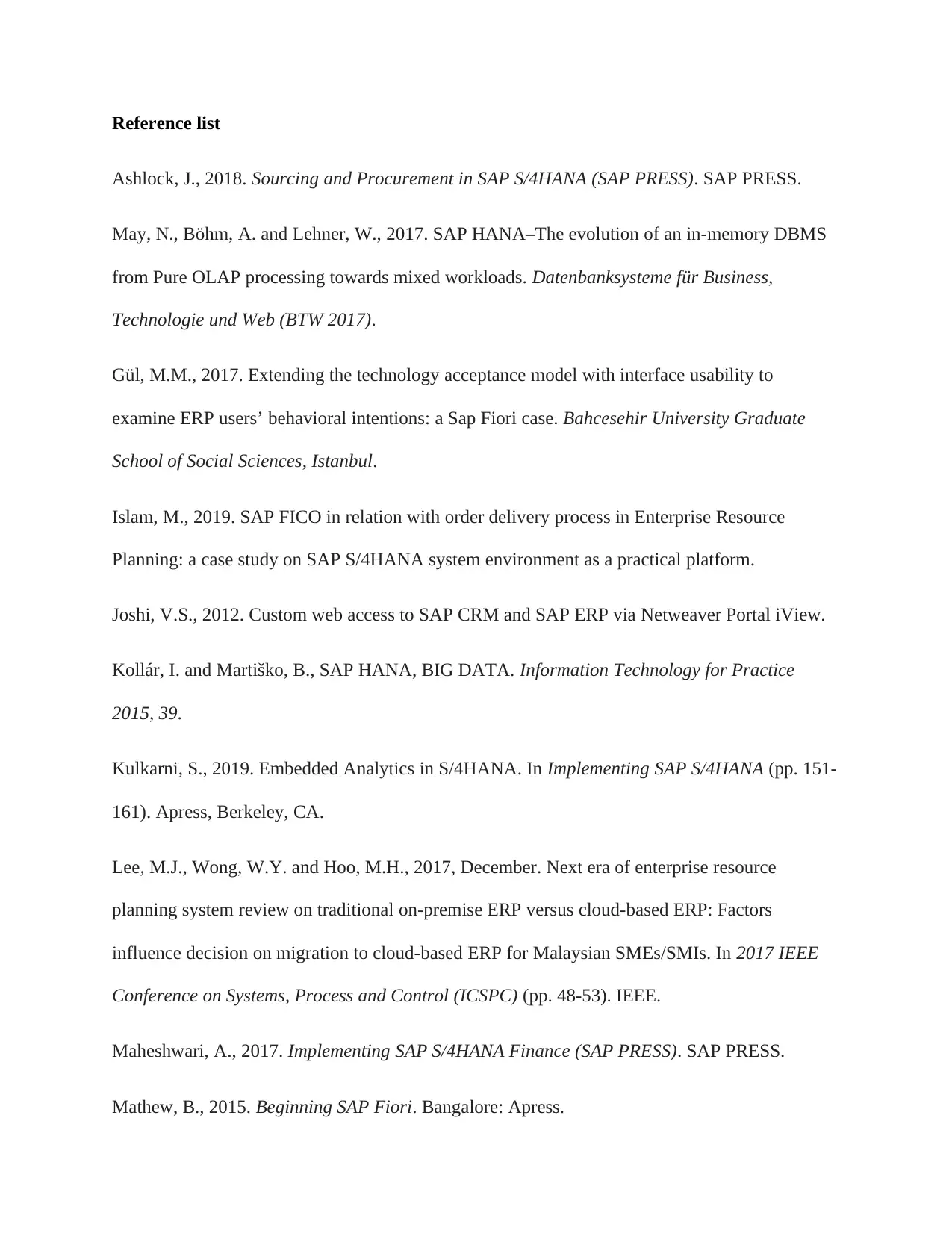
Reference list
Ashlock, J., 2018. Sourcing and Procurement in SAP S/4HANA (SAP PRESS). SAP PRESS.
May, N., Böhm, A. and Lehner, W., 2017. SAP HANA–The evolution of an in-memory DBMS
from Pure OLAP processing towards mixed workloads. Datenbanksysteme für Business,
Technologie und Web (BTW 2017).
Gül, M.M., 2017. Extending the technology acceptance model with interface usability to
examine ERP users’ behavioral intentions: a Sap Fiori case. Bahcesehir University Graduate
School of Social Sciences, Istanbul.
Islam, M., 2019. SAP FICO in relation with order delivery process in Enterprise Resource
Planning: a case study on SAP S/4HANA system environment as a practical platform.
Joshi, V.S., 2012. Custom web access to SAP CRM and SAP ERP via Netweaver Portal iView.
Kollár, I. and Martiško, B., SAP HANA, BIG DATA. Information Technology for Practice
2015, 39.
Kulkarni, S., 2019. Embedded Analytics in S/4HANA. In Implementing SAP S/4HANA (pp. 151-
161). Apress, Berkeley, CA.
Lee, M.J., Wong, W.Y. and Hoo, M.H., 2017, December. Next era of enterprise resource
planning system review on traditional on-premise ERP versus cloud-based ERP: Factors
influence decision on migration to cloud-based ERP for Malaysian SMEs/SMIs. In 2017 IEEE
Conference on Systems, Process and Control (ICSPC) (pp. 48-53). IEEE.
Maheshwari, A., 2017. Implementing SAP S/4HANA Finance (SAP PRESS). SAP PRESS.
Mathew, B., 2015. Beginning SAP Fiori. Bangalore: Apress.
Ashlock, J., 2018. Sourcing and Procurement in SAP S/4HANA (SAP PRESS). SAP PRESS.
May, N., Böhm, A. and Lehner, W., 2017. SAP HANA–The evolution of an in-memory DBMS
from Pure OLAP processing towards mixed workloads. Datenbanksysteme für Business,
Technologie und Web (BTW 2017).
Gül, M.M., 2017. Extending the technology acceptance model with interface usability to
examine ERP users’ behavioral intentions: a Sap Fiori case. Bahcesehir University Graduate
School of Social Sciences, Istanbul.
Islam, M., 2019. SAP FICO in relation with order delivery process in Enterprise Resource
Planning: a case study on SAP S/4HANA system environment as a practical platform.
Joshi, V.S., 2012. Custom web access to SAP CRM and SAP ERP via Netweaver Portal iView.
Kollár, I. and Martiško, B., SAP HANA, BIG DATA. Information Technology for Practice
2015, 39.
Kulkarni, S., 2019. Embedded Analytics in S/4HANA. In Implementing SAP S/4HANA (pp. 151-
161). Apress, Berkeley, CA.
Lee, M.J., Wong, W.Y. and Hoo, M.H., 2017, December. Next era of enterprise resource
planning system review on traditional on-premise ERP versus cloud-based ERP: Factors
influence decision on migration to cloud-based ERP for Malaysian SMEs/SMIs. In 2017 IEEE
Conference on Systems, Process and Control (ICSPC) (pp. 48-53). IEEE.
Maheshwari, A., 2017. Implementing SAP S/4HANA Finance (SAP PRESS). SAP PRESS.
Mathew, B., 2015. Beginning SAP Fiori. Bangalore: Apress.
Paraphrase This Document
Need a fresh take? Get an instant paraphrase of this document with our AI Paraphraser
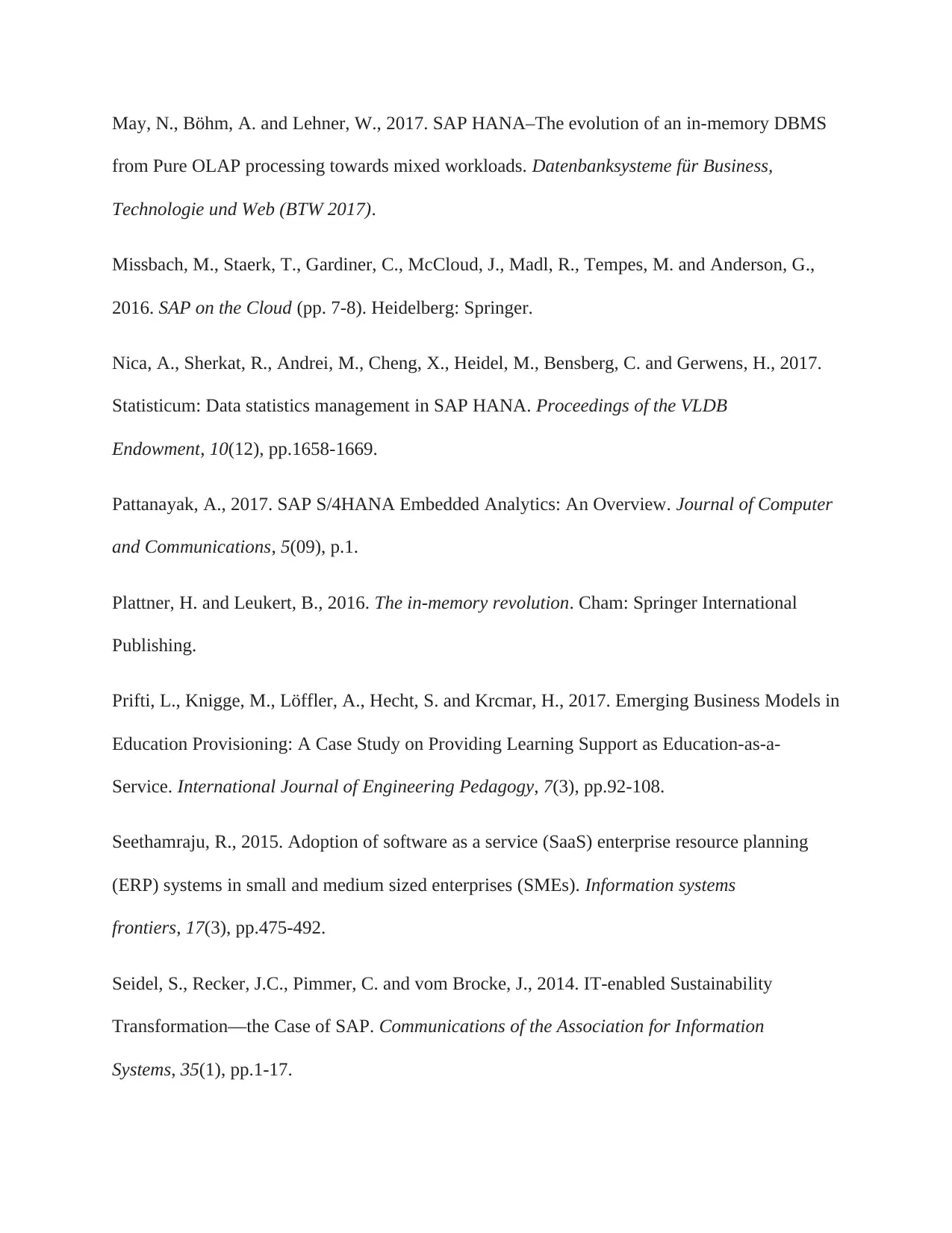
May, N., Böhm, A. and Lehner, W., 2017. SAP HANA–The evolution of an in-memory DBMS
from Pure OLAP processing towards mixed workloads. Datenbanksysteme für Business,
Technologie und Web (BTW 2017).
Missbach, M., Staerk, T., Gardiner, C., McCloud, J., Madl, R., Tempes, M. and Anderson, G.,
2016. SAP on the Cloud (pp. 7-8). Heidelberg: Springer.
Nica, A., Sherkat, R., Andrei, M., Cheng, X., Heidel, M., Bensberg, C. and Gerwens, H., 2017.
Statisticum: Data statistics management in SAP HANA. Proceedings of the VLDB
Endowment, 10(12), pp.1658-1669.
Pattanayak, A., 2017. SAP S/4HANA Embedded Analytics: An Overview. Journal of Computer
and Communications, 5(09), p.1.
Plattner, H. and Leukert, B., 2016. The in-memory revolution. Cham: Springer International
Publishing.
Prifti, L., Knigge, M., Lö ffler, A., Hecht, S. and Krcmar, H., 2017. Emerging Business Models in
Education Provisioning: A Case Study on Providing Learning Support as Education-as-a-
Service. International Journal of Engineering Pedagogy, 7(3), pp.92-108.
Seethamraju, R., 2015. Adoption of software as a service (SaaS) enterprise resource planning
(ERP) systems in small and medium sized enterprises (SMEs). Information systems
frontiers, 17(3), pp.475-492.
Seidel, S., Recker, J.C., Pimmer, C. and vom Brocke, J., 2014. IT-enabled Sustainability
Transformation—the Case of SAP. Communications of the Association for Information
Systems, 35(1), pp.1-17.
from Pure OLAP processing towards mixed workloads. Datenbanksysteme für Business,
Technologie und Web (BTW 2017).
Missbach, M., Staerk, T., Gardiner, C., McCloud, J., Madl, R., Tempes, M. and Anderson, G.,
2016. SAP on the Cloud (pp. 7-8). Heidelberg: Springer.
Nica, A., Sherkat, R., Andrei, M., Cheng, X., Heidel, M., Bensberg, C. and Gerwens, H., 2017.
Statisticum: Data statistics management in SAP HANA. Proceedings of the VLDB
Endowment, 10(12), pp.1658-1669.
Pattanayak, A., 2017. SAP S/4HANA Embedded Analytics: An Overview. Journal of Computer
and Communications, 5(09), p.1.
Plattner, H. and Leukert, B., 2016. The in-memory revolution. Cham: Springer International
Publishing.
Prifti, L., Knigge, M., Lö ffler, A., Hecht, S. and Krcmar, H., 2017. Emerging Business Models in
Education Provisioning: A Case Study on Providing Learning Support as Education-as-a-
Service. International Journal of Engineering Pedagogy, 7(3), pp.92-108.
Seethamraju, R., 2015. Adoption of software as a service (SaaS) enterprise resource planning
(ERP) systems in small and medium sized enterprises (SMEs). Information systems
frontiers, 17(3), pp.475-492.
Seidel, S., Recker, J.C., Pimmer, C. and vom Brocke, J., 2014. IT-enabled Sustainability
Transformation—the Case of SAP. Communications of the Association for Information
Systems, 35(1), pp.1-17.
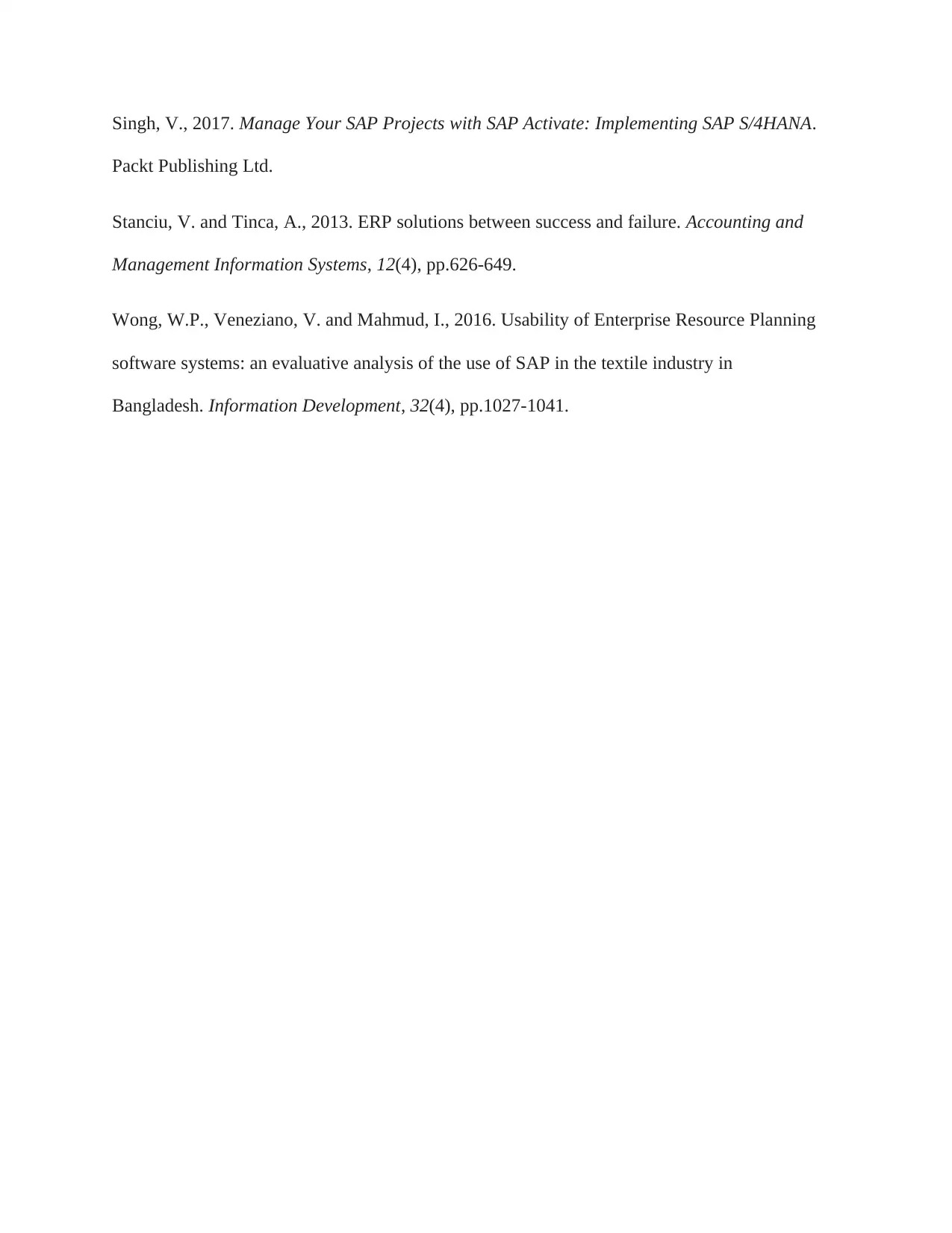
Singh, V., 2017. Manage Your SAP Projects with SAP Activate: Implementing SAP S/4HANA.
Packt Publishing Ltd.
Stanciu, V. and Tinca, A., 2013. ERP solutions between success and failure. Accounting and
Management Information Systems, 12(4), pp.626-649.
Wong, W.P., Veneziano, V. and Mahmud, I., 2016. Usability of Enterprise Resource Planning
software systems: an evaluative analysis of the use of SAP in the textile industry in
Bangladesh. Information Development, 32(4), pp.1027-1041.
Packt Publishing Ltd.
Stanciu, V. and Tinca, A., 2013. ERP solutions between success and failure. Accounting and
Management Information Systems, 12(4), pp.626-649.
Wong, W.P., Veneziano, V. and Mahmud, I., 2016. Usability of Enterprise Resource Planning
software systems: an evaluative analysis of the use of SAP in the textile industry in
Bangladesh. Information Development, 32(4), pp.1027-1041.
1 out of 15
Related Documents
Your All-in-One AI-Powered Toolkit for Academic Success.
+13062052269
info@desklib.com
Available 24*7 on WhatsApp / Email
![[object Object]](/_next/static/media/star-bottom.7253800d.svg)
Unlock your academic potential
© 2024 | Zucol Services PVT LTD | All rights reserved.





